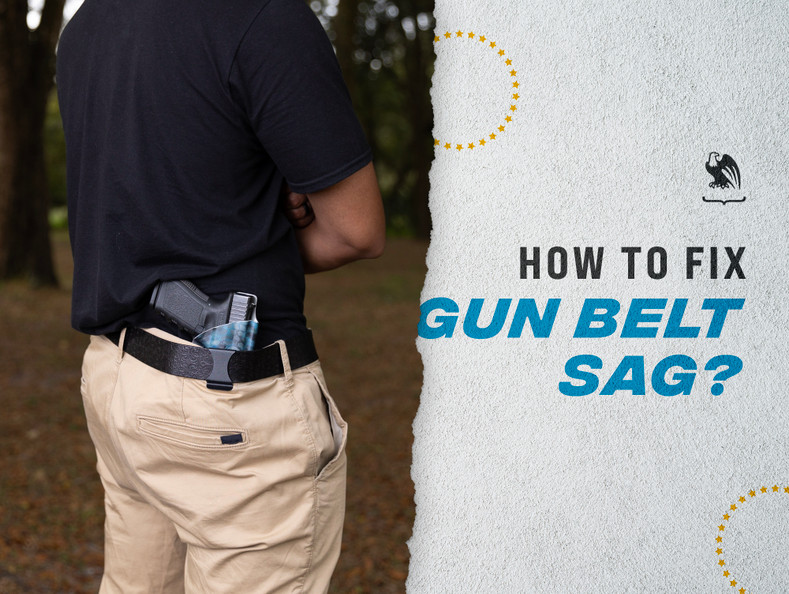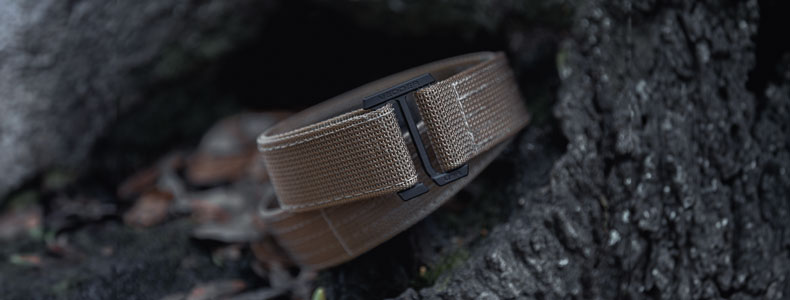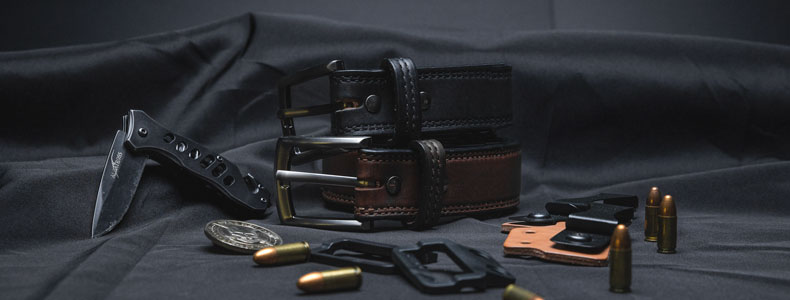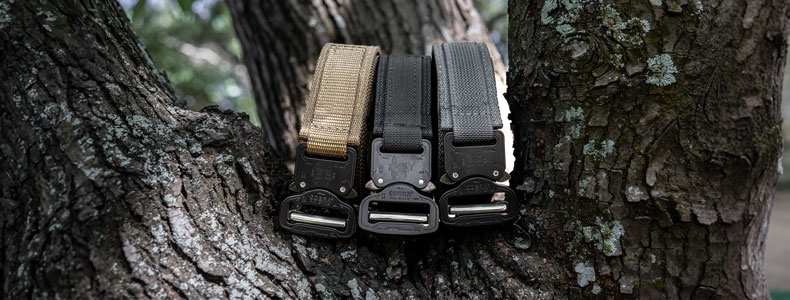Causes of Gun Belt Sag and How to Fix Them

If you’ve ever felt the sinking feeling of your carry belt and holster giving in to gravity, you’ve experienced belt sag.
Not only can a sagging belt be uncomfortable, but it can put you at risk in a defensive situation as well. Luckily, there are a few measures you can take to keep your belt right where it should be.
Gun belt sag can occur when your belt is worn out, made with low-quality materials, or doesn’t fit right. This can be prevented by investing in, and properly caring for, a quality leather or tactical belt.
So, without further ado, let’s talk about what belt sag is and how to prevent it.
Products Mentioned In This Article
What is Gun Belt Sag and Why is it a Problem?
If your belt is not sturdy enough to support your gun, holster, and other EDC gear, it may droop under the weight, often taking your pants with it. This is known as “belt sag.”
But what exactly is the problem with belt sag? Is there really any harm in it?
Well, not only can it be incredibly uncomfortable, but it can put you in danger as well.
When your belt sags, it increases the risk of your gun printing (or showing through your clothes). This can be problematic as printing informs the world that you have a firearm, which effectively takes away the element of surprise in a defensive encounter.
Not only that, but if your pistol is exposed, it makes it easy for a bad guy to grab it and take it from you. It also puts you at risk of your gun and holster falling off if you have to run or find yourself in a physical struggle.
And if that isn’t enough, belt sag can even make it more difficult, and therefore slower, to draw your weapon. It may take you a moment longer to find the grip of your gun if it isn’t exactly where you left it. It may only be a few seconds slower, but when in a self-defense situation, that could mean the difference between life and death.

What Causes Gun Belt Sag?
Any number of things can cause your belt to sag. But if you’re at a loss, here are some of the most common reasons it may be happening to you.
You Have a Low-Quality Belt
One of the biggest reasons EDC belts will start to sag is if it is made with low-end materials. Because you wear it every day and because you need it to hold a decent amount of weight, your CCW belt needs to be made with durable, long-lasting materials that will hold their shape over time. Some manufacturers tend to skimp on the quality of their nylon or leather, resulting in a belt that may sag over time or under enough weight.
But nylon and leather aren’t the only factors to consider. If you examine your belt buckle and find that it’s loose or bent, it may be the culprit causing your belt to sag.
Our Vedder Holsters concealed carry gun belts are made with premium cowhide leather and dual-layered nylon webbing designed to withstand heavy use. Our leather belts are also built with a stiff polymer core that helps maintain its rigidity under the weight of your pistol and holster. Our belts are also crafted with premium, durable belt buckles designed to last.
Your Belt is Old
No matter how well-made your belt is, it will eventually start to wear out. If your belt is beginning to sag, it may be because it’s been well-loved for a little too long. Whether your buckle is a little loose, the belt holes are stretched out, or the material has started to fray, crease, or break down, your belt will probably get a little saggy. Sometimes all your belt needs is a little maintenance and TLC, but if it’s old enough, it’s probably time for a new one.
Your Belt is the Wrong Size
This may seem like a no-brainer, but if your belt is too big, it will probably sag a little (or a lot). Whether you’ve lost some weight, bought the wrong size, or were given an ill-fitting belt as a gift, if it’s too big, even by a little bit, it will likely sag under the weight of your gun. Unfortunately, there’s really no way to fix this besides punching a new hole in your belt. It’s probably better to just use it as an excuse to buy a new concealed carry belt (like you need one).
Your Body Shape

Listen, here at Vedder Holsters, we’re not about body shaming. But unfortunately, for some of us, body shape plays a role in whether or not our gun belt sags.
Firearm owners with larger bellies tend to experience belt sag if their waist is wider than their hips. This can put pressure on the top of a belt, causing it to sag downward. Obviously, the extent to which this happens depends on your body, but if your belt is sagging, this could be why.
Those with smaller behinds also tend to experience belt sag. If you have a larger midsection and a smaller rear end, you probably already know that’s why your belt is sagging. This one is pretty difficult to remedy without squats or butt implants (though that’s always an option), but ensuring your belt fits nice and snug may help at least a little bit.
How to Prevent Concealed Carry Belt Sag

Whatever the reason for your gun belt sag, you can take steps to minimize this annoying phenomenon.
Get a New Belt
Even though quality gun belts tend to last a long time, they do eventually start to wear out, especially with daily use.
If your belt is starting to sag simply because it’s old and has lost its stiffness, it no longer fits you, it’s stretched out, or the buckle is not what it used to be, it’s time to get a new belt.
Luckily, this is no big deal if you have a Vedder Holsters gun belt. All of our products are backed by a lifetime guarantee, so if you’ve loved your concealed carry belt to death, let us know.
If you’re unsure whether it’s time to trade your old belt for a new one, check out our 9 Signs You Need A New EDC Belt article.
Properly Care For Your Gun Belt
As with most things, proper care of your CCW belt can significantly extend its life and delay the inevitable sagging that comes with age. This is especially true when it comes to leather belts.
Properly storing, cleaning, and maintaining your belt is essential. It’s important that you don’t casually hang your belts over a chair, dump them into a drawer all together, or bury them under a mound of laundry, which can cause them to crease and lose their stiffness.
With leather concealed carry belts, regularly conditioning them can help keep the leather in good shape so that it remains sturdy and capable of holding even your heaviest carry pistol in place.
For more information about how to care for your gun belt, click here.
Pair With a Quality Holster
We don’t have to tell you that a quality holster can make or break your carry experience. When you use a holster that’s too heavy or ill-fitting, it can not only make for an uncomfortable and potentially dangerous situation, but it can also cause belt sag and wear.
An easy solution to this problem is to trade your old holster for a new, better one.
Be sure to choose a holster that is as lightweight as possible without sacrificing durability and features. If your holster is too heavy, it will put unnecessary weight on your belt, causing it to sag.
It’s also important that your holster’s clip is fitted correctly to your belt so it doesn’t rub against or pinch your belt. This will break down the material over time, making it prone to sagging.
We offer a multitude of quality Kydex and hybrid IWB and OWB concealed carry holsters here at Vedder Holsters. Each is made with durable, high-quality materials, sturdy clips, and adjustable features, all while remaining lightweight and comfortable.
What Should I Look for in an EDC Belt?

As we’ve already mentioned, preventing belt sag starts with wearing the right belt. Here are some of the features you should look for in a quality carry belt that won’t leave you hanging.
Stiffness: The rigidity of your belt is the number one factor in whether or not it will sag. So, be sure to invest in a belt that is stiff enough to easily support your firearm, holster, and other EDC items. Gun belts with dual layers and firm cores are ideal when it comes to stiffness.
Thickness: A contributing factor to the stiffness of your belt is its thickness. Look for a belt that’s made with dual layers, or is at least thick enough to hold its shape and support your holster without leaving so much room that it slides around.
Material: Whether you choose a nylon or leather gun belt, make sure it’s made of quality, durable materials. Otherwise, your belt is liable to wear out and sag well before its time.
Buckle: Because a poorly-designed belt buckle can cause sagging and a potentially dangerous situation if it comes undone, it’s essential to look for a belt with a quality buckle made with high-end materials and a strong design.
Proper Fit: Once you’ve found a belt that checks all the boxes, it’s important to make sure it fits properly. An ill-fitting belt can not only be a hazard in a self-defense situation, but it will almost certainly cause belt sag and premature wear and tear. Check out our instructional video on how to pick the right sized gun belt here.
Summary
Gun belt sag occurs when your belt doesn’t fit correctly, is worn out, or is made with low-quality materials. Preventing belt sag is simple. Investing in a quality belt and properly caring for it can add years to your belt’s life and ensure it does what it needs to.
If you’re looking for belts or holsters, we recommend visiting our Holsters by Gun Model page if you are looking for holsters that are custom-made for your weapon of choice. For all of our belt and holster options and for more information to help you choose the carry system that works best for you, visit our Vedder Holsters website.
Looking for items beyond holsters and belts, check out our Resources Page for popular product links like lights, lasers, first aid, maintenance, and more.




